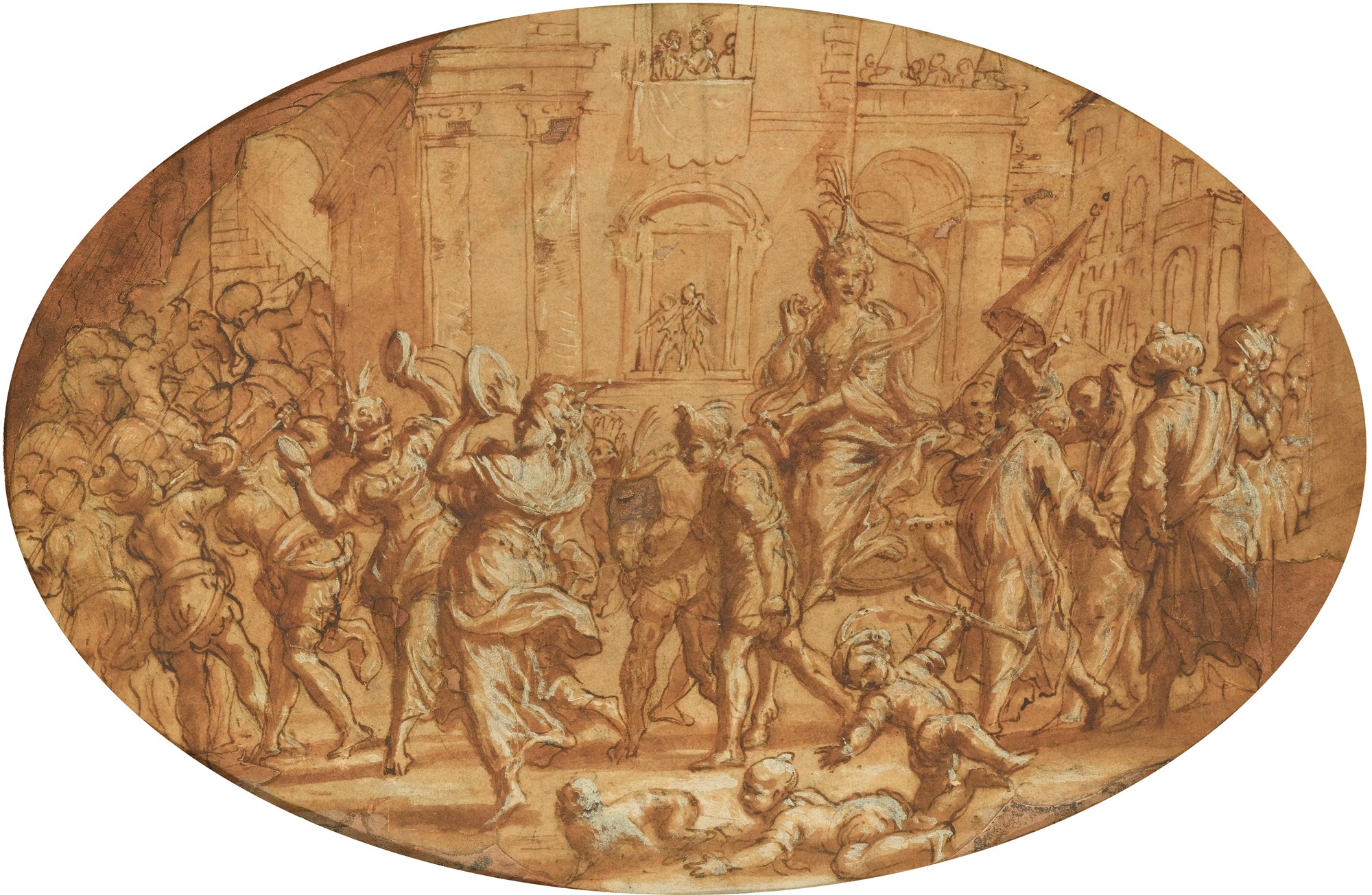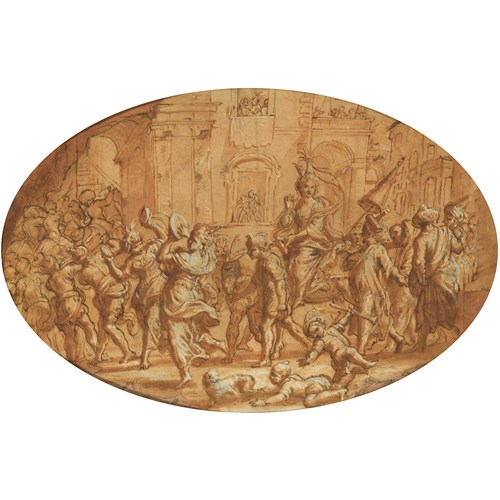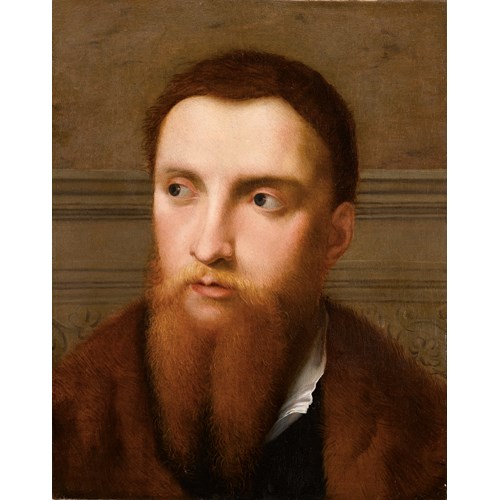Marketplace
A Processional Feast with Musicians and People in Costume, a Woman on a Horse at the Centre
Giovanni Maria Morandi
A Processional Feast with Musicians and People in Costume, a Woman on a Horse at the Centre
Epoque 1600-1750, 17th century, 18th century
Origine Italy
Medium Pen, Brown ink, Brown wash
Dimension 20.5 x 30.5 cm (8¹/₈ x 12 inches)
In A Processional Feast with Musicians and People in Costume, a Woman on a Horse at the Centre, which is attributed to Giovanni Maria Morandi, we are presented with an image of joyous celebration in a spirited and expressive manner. The scene takes place in an Italian square and the party of revellers is centred on an elaborately dressed woman riding a horse. Her dramatically spiked headdress and flowing drapery echoes the frenzied movement around her of barefoot men in oriental dress and women with garlands in their hair. The men blow on horns while the women strike tambourines and cymbals, forming a procession reaching horizontally across the paper. From the open windows and on the roof of a loggia in the square, people have assembled to watch the spectacle, which appears to be either a fashionable masquerade or a festival.
The work exhibits a painterly spontaneity and freedom in the application of pen and brush marks that equals the subject in its vitality. The combination of dark outlines around the forms of the figures and the white heightening of the costume folds add to the drawing’s depth and texture, while the use of chiaroscuro intensifies its dramatic impact. The sense of movement and theatricality and the hasty, informal draughtsmanship of A Processional Feast with Musicians and People in Costume, a Woman on a Horse at the Centre are in harmony with Morandi’s style.
Morandi was born in Florence and was mainly active in his native city and Rome, although he also worked in Venice. He trained under Giovanni Biliverti in Florence. In Rome, he became a member of the Accademia di San Luca in 1657 and was elected principe twice in the following years. He painted numerous altarpieces in Rome, including the Death of Mary in the church of Santa Maria della Pace and pieces in Santa Maria in Vallicella and Santa Maria del Popolo. In Siena, he painted the Annunciation in the church of Santa Maria della Scalla. The Prado, Madrid, and several Italian collections house examples of his religious works. Morandi was also a portraitist and several of his portraits can be seen in the Kunsthistorisches Musem in Vienna. Although works by Morandi are now rare, there is evidence that he was a sought-after artist in his time, for as Paolo Bellini notes, ‘the abundance of etchings after Morandi is testimony to his contemporary success’.¹
A drawing by Morandi with similar subject matter is in the Louvre, Paris.²
¹ Paolo Bellini, The Illustrated Bartch, 47 (Vol. 1), commentary, p. 12.
² De la Renaissance à l’Age baroque. Une collection de dessins italiens pour les musées de France, exhib. cat., Paris, Louvre, 2005, no. 113.
The work exhibits a painterly spontaneity and freedom in the application of pen and brush marks that equals the subject in its vitality. The combination of dark outlines around the forms of the figures and the white heightening of the costume folds add to the drawing’s depth and texture, while the use of chiaroscuro intensifies its dramatic impact. The sense of movement and theatricality and the hasty, informal draughtsmanship of A Processional Feast with Musicians and People in Costume, a Woman on a Horse at the Centre are in harmony with Morandi’s style.
Morandi was born in Florence and was mainly active in his native city and Rome, although he also worked in Venice. He trained under Giovanni Biliverti in Florence. In Rome, he became a member of the Accademia di San Luca in 1657 and was elected principe twice in the following years. He painted numerous altarpieces in Rome, including the Death of Mary in the church of Santa Maria della Pace and pieces in Santa Maria in Vallicella and Santa Maria del Popolo. In Siena, he painted the Annunciation in the church of Santa Maria della Scalla. The Prado, Madrid, and several Italian collections house examples of his religious works. Morandi was also a portraitist and several of his portraits can be seen in the Kunsthistorisches Musem in Vienna. Although works by Morandi are now rare, there is evidence that he was a sought-after artist in his time, for as Paolo Bellini notes, ‘the abundance of etchings after Morandi is testimony to his contemporary success’.¹
A drawing by Morandi with similar subject matter is in the Louvre, Paris.²
¹ Paolo Bellini, The Illustrated Bartch, 47 (Vol. 1), commentary, p. 12.
² De la Renaissance à l’Age baroque. Une collection de dessins italiens pour les musées de France, exhib. cat., Paris, Louvre, 2005, no. 113.
Epoque: 1600-1750, 17th century, 18th century
Origine: Italy
Medium: Pen, Brown ink, Brown wash
Dimension: 20.5 x 30.5 cm (8¹/₈ x 12 inches)
Plus d'œuvres d'art de la Galerie









